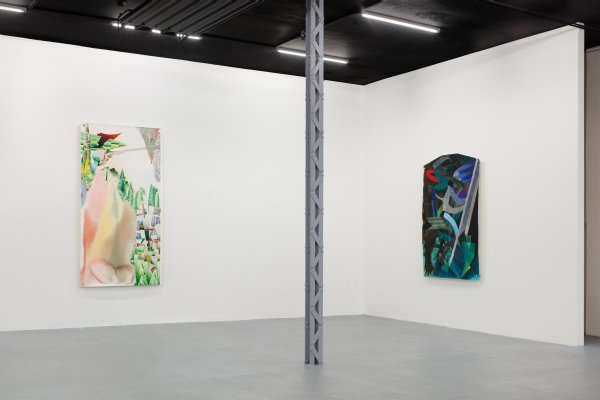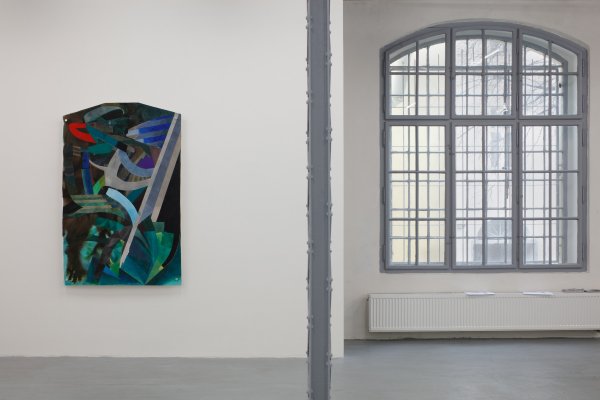Lukáš Karbus
Fractured Side
16.3.2017–6.5.2017 Prague Curated by Jiří Havlíček- Text by Jiří Havlíček (EN)
- Text by Jiří Havlíček (CZ)
A forest is an area where trees grow. Dense forests gradually became normalized vegetation zones, and this simple definition is almost an oxymoron. Scientists have recently questioned the origins of the Amazon rainforest, and the biggest vanishing wilderness in the world suddenly became a mere unkempt, domesticated space.
Contemporary architecture, at least symbolically, tries to respond to environmental changes. A few years ago, high-rise buildings with planted trees were constructed in the center of Milan, Italy. Forested skyscrapers, which use the built-up area on several levels simultaneously, carry the literal name Bosco Verticale - Vertical Forest. Horizontal forests also exist. In the beginning of the cartoon The Mole in Town, we see the idyllic natural scenery, which is disrupted by the sound of a chainsaw.
A close up of a falling tree shifts to an aerial view of a clearing with fallen pines. We see a monochromatically tuned image in shades of green, a forest taken apart into individual building modules. Cut. Bulldozers appear on the horizon, and the construction of the city begins. Beneath the cobblestones is an invisible forest.
In Lukáš Karbus’s large-scale watercolors, we find a similar fragmentation of the basic building block of a forest, the tree. Multiple trunks, geometrized crowns, abstracted leaf stalk. Individual elements appear in groups and independently. Accompanied with purely abstract shapes, they create the overall architecture of the image. Dynamic landscapes, like a Romantic painting, become a mirror of subjective experience.
The visible similarity with nature varies depending on the artist’s internal positioning. In place of photographically faithful images of the surrounding terrain, Karbus captures a full reflection of momentary associations. Straight clean edges pass through blurred boundaries - daydreaming merges with reality. According to Jacques Lacan, the real is a traumatic blank space. It is an invisible residue that we notice only through the cracks and gaps of evident reality. When we restrict ourselves to only what we see, we miss the fundamental. Boundaries of reality are as fuzzy as forest borders.
Les je území, kde rostou stromy. Z nepřehledných pralesů se postupně staly normované vegetační zóny a z jednoduché definice je téměř protimluv. Vědci nedávno zpochybnili původnost amazonské džungle a z největší mizející divočiny na světě se rázem stal jen neudržovaný domestikovaný prostor.
Současná architektura se alespoň symbolicky snaží reagovat na environmentální změny. V centru italského Milána před pár lety vyrostly výškové budovy osázené dřevinami. Zalesněné mrakodrapy, využívající zastavěnou plochu na několika úrovních současně, nesou doslovný název Bosco Verticale – vertikální les. Existuje také horizontální les. Na začátku kresleného filmu Krtek ve městě sledujeme idylickou přírodní scénu, kterou naruší zvuk motorové pily. Záběr na padající strom vystřídá celkový pohled na paseku s ležícími jehličnany. Monochromaticky laděný obraz v odstínech zelené, les rozložený na jednotlivé stylizované moduly. Střih. Na horizontu se objeví buldozery, začíná výstavba velkoměsta. Pod dlažebními kostkami je neviditelný les.
Na velkoformátových akvarelech Lukáše Karbuse najdeme podobnou fragmentarizaci základní stavební jednotky lesa – stromu. Znásobené kmeny, geometrizované koruny stromů, abstrahované žebroví listů. Jednotlivé prvky se objevují ve skupinách i samostatně a společně s čistě abstraktními tvary vytváří celkovou architekturu obrazu. Dynamické krajiny, které se podobně jako v romantickém malířství stávají zrcadlem subjektivní zkušenosti.
Viditelná podobnost s přírodou se mění v závislosti na autorově vnitřním nastavení. Namísto fotograficky věrných obrazů okolního terénu zachycuje odraz plný momentálních asociací. Přímé čisté hrany přecházejí v rozpité okraje - denní snění splývá s realitou. Podle Jacques Lacana je reálno traumatické prázdné místo. Neviditelný zbytek, který zahlédneme pouze v trhlinách a mezerách zjevné reality. Když se omezíme jen na to, co vidíme, uniká nám to podstatné. Hranice skutečnosti je stejně nejasná jako hranice lesa.














